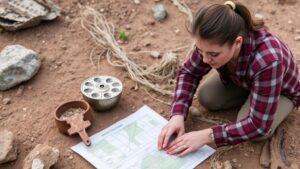How to Detect Relics in Old Schoolhouses and Historic Buildings
How to Detect Relics in Old Schoolhouses and Historic Buildings
The quest to uncover relics in old schoolhouses and historic buildings presents a unique blend of historical exploration and archaeological discovery. These structures often reflect the cultural and educational nuances of their time, housing artifacts that tell compelling stories. Detecting relics requires a systematic approach that incorporates architectural expertise, historical context, and careful methodological practices.
The Importance of Historic Context
Understanding the historical backdrop of a schoolhouse or building is crucial before embarking on a relic detection mission. Factors such as the buildings age, geographic location, and architectural style can provide vital clues about potential artifacts. For example, many schoolhouses built in the late 19th and early 20th centuries may contain remnants of early educational materials, such as chalkboards or textbooks, which can reflect the pedagogical methods of the time.
Statistics show that around 30% of historic schoolhouses in the United States have been converted into community centers or other uses, potentially preserving original features and artifacts. This presents both opportunities and challenges for relic hunters. Conducting thorough research through local archives, historical societies, and online databases can yield information about prior uses of the building, significant events, and even the people associated with it.
Visual Inspection Techniques
The first step in detecting relics is to perform a comprehensive visual inspection of the buildings interior and exterior. This involves looking for signs of wear, alterations, or unique architectural features that may suggest hidden artifacts. Specific techniques include:
- Surface Examination: Look for inconsistencies in the wall materials, flooring types, or other structural elements that may indicate areas where items have been concealed or buried.
- Photographic Documentation: Taking detailed photographs of unique features or areas of interest can help in later analyses and comparisons.
In many cases, relics can be hidden in locations that seem mundane at first glance. For example, a restoration project in a Massachusetts schoolhouse revealed old textbooks hidden within the walls, left as a memento by previous occupants. Understanding the architectural design can help direct focus on likely areas where artifacts might be found, including basements, attics, and crawl spaces.
Archaeological Methods for Detection
For more thorough investigations, applying archaeological methods can significantly improve the chances of detecting relics. These methods may include:
- Ground Penetrating Radar (GPR): This non-invasive technique allows you to visualize subsurface materials without excavation, providing insights into what lies beneath floors or within walls.
- Magnetometry: This technique detects magnetic anomalies caused by buried materials, which can indicate locations where historical artifacts may be found.
In a notable case study, GPR was used in a historic schoolhouse in Virginia, revealing buried structural foundations that were previously unknown. This technology not only helped in uncovering hidden relics but also informed preservation efforts while maintaining the sites historical integrity.
Documentation and Preservation
Once relics are detected and excavated, proper documentation and preservation are essential. Every discovery should be logged with details such as the date, exact location, and context of the find. Consider the following methods for documentation:
- Artifact Cataloging: Organize finds using a structured cataloging system that records materials, sizes, and any related information.
- Condition Reporting: Assessing the condition of each relic helps in planning for conservation efforts and future display.
To illustrate these principles, a restoration project in Californias old schoolhouses showcased how meticulous documentation allowed historians to make informed decisions about conserving original materials while accommodating modern functionality. This careful balance ensured that both the history and functionality of the building remained intact.
Legal and Ethical Considerations
Before initiating the search for relics, it is essential to understand the legalities involved in artifact discovery. Many areas have regulations regarding the excavation of historical sites. Permission from local historical societies or government bodies may be required, especially in protected areas. Ethical considerations should also guide actions; it is crucial to respect the history and significance of the site, avoiding unnecessary damage.
Conclusion
Detecting relics in old schoolhouses and historic buildings is a rewarding endeavor that connects today’s society with its past. Through a combination of historical research, visual inspection techniques, archaeological methods, and ethical practices, enthusiasts can uncover valuable artifacts that tell the story of education and community development over the years.
For those interested in this field, actionable takeaways include:
- Conduct thorough historical research before investigating a site.
- Employ both visual and technological methods to enhance detection efforts.
- Document discoveries meticulously for future reference and preservation.
- Respect legal and ethical frameworks surrounding relic detection and preservation.
By adhering to these principles, relic hunters can contribute significantly to our understanding of history while ensuring the preservation of invaluable educational heritage.



